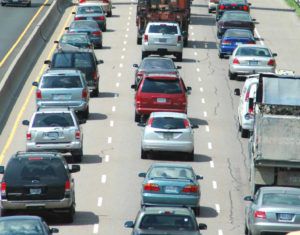Phillip Sean Curran, Staff Writer
By Philip Sean Curran, Staff Writer
The state is looking to add two travel lanes to a stretch of Route 1 near Princeton beginning in four years, in a move to improve the flow of traffic on a busy north-south highway seen as vital for the region’s economy.
State Department of Transportation spokesman Daniel Triana said Tuesday that “the project is in the early stages of concept development.” He said construction is expected to start in 2021, but he said it was too soon to say how much the job would cost.
“The NJDOT Route 1 Improvements project in Mercer County will seek to alleviate traffic congestion and improve operational safety on Route 1 for approximately one mile between Alexander Road in West Windsor and Mapleton Road in Plainsboro,” he said by email. “After conducting initial traffic investigations, preliminary plans are to widen Route 1 from three lanes to four lanes in each direction, while maintaining shoulders and performing traffic signal modifications.”
He said the state has been in talks with the towns of Princeton, West Windsor and Plainsboro along with Princeton University and University Medical Center, both of whom are large employers in the region.
West Windsor Mayor Shing-Fu Hsueh said Tuesday that based on his conversations with DOT leaders past and present, including current DOT commissioner Richard T. Hammer, the state was willing to move ahead with the plan as long as there was “clear consensus” on the part of the five towns along the Route 1 corridor, including South Brunswick and Lawrence, and the university.
“I kind of feel that is the reason DOT agreed, as long we are all on the same page. They will be willing to move forward and appropriate the budget for starting next year for the improvements,” he said.
The university, the largest private sector employer in the county, has had a seat at the table.
“I think at this point, what we see is the commissioner coming forward and saying that they want to look further and begin to start to study ways to add an additional lane along Route One,” said university director of community and regional affairs Kristin S. Appelget on Wednesday. “I think there’s an acknowledgment that it’s not the long-term solution, but it’s potentially an interim solution that could provide relief for commuters.”
Mayor Hsueh said the added traffic lanes would be located between the Dinky Bridge and the Millstone River, with most of the property for the expansion coming from university-owned land on the western side of the highway. He said he believes the university would be donating the property for the project. But there have been no discussions on how the land would be transferred, through a donation or a sale.
One state lawmaker this week welcomed the news about the road improvements and said Route 1 is critical for the economy.
“The Route One corridor is crucial to the flow of people commuting to work every day,” Assemblyman Andrew Zwicker (D-16) said Tuesday by phone. “As someone who drives that road to get to various places in the district or to the university and laboratory, I see the bottleneck that happens heading into Harrison (Street) every single day. Time is money. Anything we can do we should be doing to try to improve the commuting time, I definitely support.”
He pointed to how well a pilot program the state is having, also on Route 1, in South Brunswick, to let motorists use the shoulder in parts of the morning and late afternoon on weekdays.
He said it’s “clear evidence that widening Route One down in this area, which has been historically always an issue, will increase the flow (and) reduce people’s travel time.”
The state has looked at addressing Route 1 before. In 2012, the DOT did a traffic study by closing jug handle turns into Princeton to improve the flow of traffic on the highway, Mayor Liz Lempert said Monday.
“So it was successful in doing that, but it created serious other problems,” she said of an idea that the DOT quickly scraped amid gridlock.
She said a shortcoming of this latest plan is that it focuses “primarily” on north-south traffic, without addressing east-west. She said the state is eyeing a later phase to improve the traffic in those directions.
“It’s not one hundred percent,” Mayor Hsueh said, “but it’s better than no improvements at all.”

